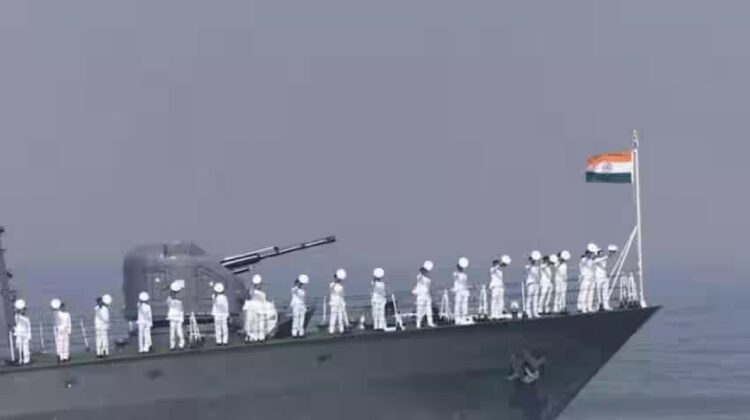
Indian Navy plays important role in the Indian Ocean Region on anti-piracy missions to counter Somali pirates
NEW DELHI : The Indian Navy is playing an important role as a security provider in the Indian Ocean Region, with repeated operations demonstrating its capabilities, particularly in the north-western Indian Ocean, where security risks have increased due to the twin problems of Houthi attacks on shipping in the Red Sea and the Gulf of Aden, and piracy off the coast of Africa. This has strengthened Indian Navy’s credentials and India’s reputation as a first responder and a force for peace and stability in the area.
The Indian Navy has rescued commercial ships hit by Houthi drones or missiles, thwarted piracy attempts, undertaken missions to rescue hijacked ships and their crews, investigated a large number of fishing vessels, and boarded vessels of interest in an ongoing effort to ensure the safety of merchant shipping and seafarers.
The Indian Navy has been deployed on anti-piracy missions for several years now to counter Somali pirates off the east coast of Africa. However, the Israel-Hamas war in Gaza, with parties such as the Iran-backed Houthi terrorists in Yemen becoming engaged and responding by attacking commercial vessels in the Red Sea, has increased the Indian Navy’s responsibilities, and it has responded to the challenge.
The attack on MV Chem Pluto, which occurred about 220 nautical miles off India’s coast, prompted the Indian Navy to increase its presence and deploy more than 10 frontline warships, including its modern Kolkata and Visakhapatnam-class destroyers, Talwar and Shivalik-class frigates, as well as aerial assets such as the P8I maritime patrol aircraft and MQ-9 drones, and marine commandos (MARCOS). The Indian Navy chief had warned troublemakers that, empowered by the Maritime Anti-Piracy Act of 2022, the Indian Navy would board suspicious vessels, and conduct anti-drone operations.
Since the attack on MV Chem Pluto in December last year, the Indian Navy has rescued at least six commercial ships that have been attacked by Houthi drones or missiles. Prominent among these was the operation by INS Visakhapatnam to extinguish a fire on the British oil tanker MV Marlin Luanda on January 27, following a Houthi missile strike in the Gulf of Aden. The operation lasted six hours. The ship’s crew consisted of 22 Indian seamen.
During the same period, the Indian Navy rescued at least seven ships that had been targeted by pirates. The most recent occurred on March 16, when the navy tracked a hijacked commercial vessel named Ruen, which was being utilised as a pirate ship. In this operation, the Indian Navy demonstrated new capabilities by dropping marine commandos (MARCOS) and two Combat Rubberised Raiding Craft from an Indian Air Force C-17 strategic lift aircraft that flew 10 hours and some 2,600 kilometres from Indian shores to the northern Arabian Sea, where the Indian Navy destroyer INS Kolkata had already intercepted the pirate ship. The pirates shot down a drone and fired on the vessel. The operation caused the pirates to surrender, resulting in the rescue of the ship with its crew of 17, and 37,800 tons of cargo.
This is the first time the Indian Navy has undertaken such an operation, displaying jointness with the Indian Air Force. Incidentally, the Indian Navy and the Indian Air Force had conducted a training exercise just a few months ago, in September 2023, when they undertook the maiden airdrop of a rigid hull inflatable boat from an IAF C-17 aircraft off Visakhapatnam. The drop was followed by combat freefall at sea by MARCOS.
The Indian Navy’s continuing operation in securing the sea lanes has drawn attention and praise from the international community. External Affairs Minister S Jaishankar remarked that “people look at us much more warmly, and much more friendly as a result of what we do now”. Defence Minister Rajnath Singh asserted that the “Navy is ensuring that no country, with its overwhelming economic and military power, is able to assert dominance over friendly countries or threaten their sovereignty. The readiness with which the Navy stands with the country’s allies provides substantive strength to India’s global values” — an oblique reference to China, which has increased its presence in the Indian Ocean Region.
Interestingly, the Chinese navy, which has a base in Djibouti in the Gulf of Aden, has been conspicuously absent in responding to missile and drone strikes on ships, as well as in combating piracy. Curiously enough, China has previously used anti-piracy activities as a reason for deploying submarines! This just demonstrates that China is not a responsible player working for the global good, but rather pursuing its own strategic goals.
The Indian Navy must continue to be deployed in larger numbers to protect India’s interests. The Arabian Sea transports 60% of India’s oil and 50% of its overall trade. India is actively pursuing the new India-Middle East-Europe Corridor (IMEC) to boost commerce and connectivity. India and the United Arab Emirates (UAE) have inked a framework agreement to make the IMEC operational. Despite the regional security issues, Greece, which serves as the IMEC’s point of entry into Europe, has expressed interest in moving forward with the project.
While the region’s waterways are getting increasingly insecure, necessitating increased deployments, the Indian Navy continues to be woefully short on numbers across platforms — from surface ships to submarines. Since naval acquisition timelines run into several years, India has to get serious about timely decisions on naval acquisitions and speedy construction and commissioning into service.
